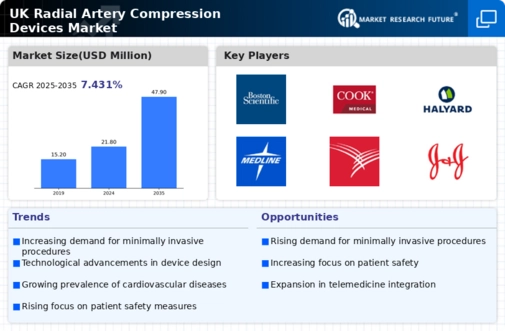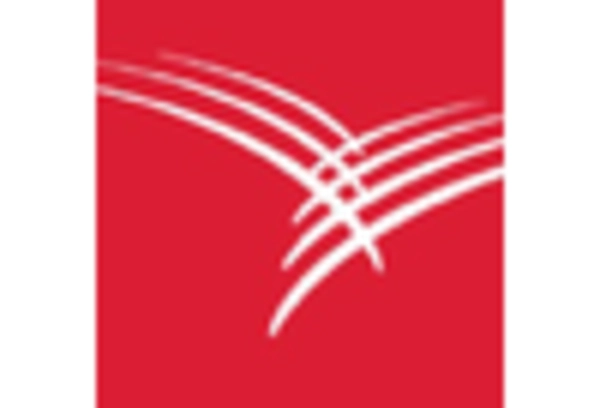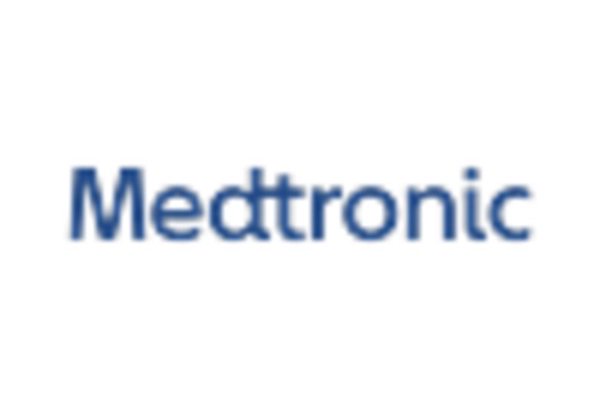Growing Geriatric Population
The growing geriatric population in the UK is a significant driver for the radial artery-compression-devices market. As individuals age, the prevalence of cardiovascular diseases tends to increase, leading to a higher demand for interventions that require effective compression solutions. By 2025, it is projected that over 18% of the UK population will be aged 65 and above, creating a substantial market for devices that cater to this demographic. The radial artery-compression-devices market is poised to expand as healthcare providers focus on delivering tailored solutions for older patients, who may require specialized care during and after cardiovascular procedures. This demographic shift underscores the importance of developing devices that address the unique needs of the aging population.
Government Initiatives and Funding
Government initiatives aimed at improving healthcare infrastructure in the UK are positively impacting the radial artery-compression-devices market. Increased funding for cardiovascular health programs has led to the procurement of advanced medical devices, including compression devices. In 2025, the UK government allocated an additional £50 million to enhance cardiac care services, which is expected to boost the adoption of radial artery-compression devices in hospitals. This financial support not only facilitates the acquisition of new technologies but also encourages research and development in the field. Consequently, the radial artery-compression-devices market is likely to benefit from these initiatives, as healthcare providers seek to enhance patient care and outcomes.
Increasing Cardiovascular Procedures
The rise in cardiovascular procedures in the UK is a primary driver for the radial artery-compression-devices market. As healthcare providers increasingly adopt minimally invasive techniques, the demand for effective compression devices has surged. In 2025, it is estimated that over 200,000 coronary interventions will be performed annually in the UK, necessitating reliable compression solutions. This trend indicates a growing need for devices that ensure patient safety and comfort post-procedure. Furthermore, advancements in catheterization techniques have led to a higher volume of radial access procedures, further propelling the market. The radial artery-compression-devices market is thus positioned to benefit from this upward trajectory in cardiovascular interventions.
Rising Awareness of Radial Access Benefits
There is a notable increase in awareness regarding the benefits of radial access over femoral access in cardiovascular procedures. Medical professionals in the UK are increasingly recognizing that radial access can lead to reduced complications and quicker recovery times for patients. This shift in preference is likely to drive the demand for radial artery-compression-devices, as these devices are essential for ensuring hemostasis post-procedure. The radial artery-compression-devices market is expected to grow as more healthcare institutions adopt radial access techniques, with studies indicating a potential increase in usage by up to 30% in the coming years. This growing awareness among practitioners and patients alike is a significant factor influencing market dynamics.
Technological Innovations in Device Design
Technological innovations play a crucial role in shaping the radial artery-compression-devices market. The introduction of advanced materials and designs has led to the development of more effective and user-friendly compression devices. For instance, devices that incorporate smart technology for monitoring pressure and ensuring optimal compression are gaining traction. The market is projected to witness a growth rate of approximately 15% annually, driven by these innovations. Additionally, the integration of ergonomic designs enhances usability for healthcare professionals, thereby improving patient outcomes. As technology continues to evolve, the radial artery-compression-devices market is likely to experience significant advancements that cater to the needs of both patients and medical practitioners.

















Leave a Comment